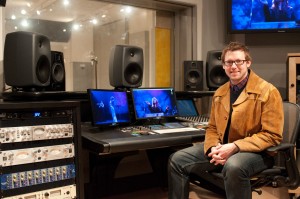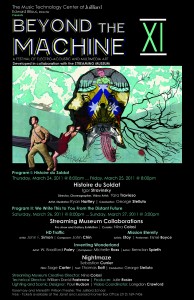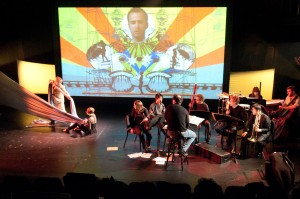Inside the Juilliard Music Technology Center: Shaping the "Beyond The Machine XI" Multimedia Event
LINCOLN CENTER, MANHATTAN: What do you think of when you hear the word “Juilliard”? I personally always pictured something like a scene out of the movie “Fame” taking place on campus: tomorrow’s star performers in every hallway, their collective talent taking on a palpable charisma.

The Juilliard Music Technology Center keeps advancing: Technical Director William David Fastenow in the studio.
When I finally took a walk through the school’s artistic entrance on my way to their totally renovated Music Technology Center, it all materialized – at this legendary performing arts conservatory founded in 1905, tomorrow’s star performers are in every hallway. Their collective talent gains an electric life of its own, intensifying as you traverse the corridors.
Inside Juilliard’s Music Technology Center (MTC), which was created in 1993 by MTC Director Edward Bilous, a major update has continued to bolster its offerings to Julliard’s students, courtesy of a new three-room recording studio/rehearsal studio/mix room suite, complete with Euphonix System 5-MC console.
In addition to its day-to-day role, the department also hosts the annual Beyond the Machine festival of electronic music and multimedia, which features new works by Juilliard students and faculty, plus commissioned artists from outside the school. Those lucky enough to score seats leave with their preconceived notions of sensation temporarily torn apart.
SonicScoop sat down with William David Fastenow, Technical Director, Juilliard Music Technology Center, for more on the MTC and Beyond the Machine XI, taking place in two installments, Thursday March 24-27 at Juilliard’s Rosemary and Meredith Wilson Theater.
Why was the Music Technology Center significantly expanded last year?
This is an important thing we’re doing. The students are getting a lot out of it, learning how to interact with technology as musicians with the current music industry. The administration and Juilliard’s donors understood we needed to expand this facility to help the students succeed.
A lot of our students are interested in being session players, film composers or interactive musicians. The MTC helps them to know a little more about technology so they’re not so blind when they enter into these pro situations, after they leave Juilliard.
When Ed Bilous, the Director of Music Technology at Juilliard, started the department in 1993, he knew that this center was something that really needed to happen. Otherwise, students would go into the world and be lost in a studio. Not knowing how to adapt to a facility like this would affect their ability to act in the world as a professional musician. It’s been great working with him in this space – it’s a launching pad and a milestone for the school and this department.
The growth here has been extraordinary, and interest among the students has never been higher. Classes here are ongoing, and the studio is filling up with students that are using it every single day. They’re recording music in session, editing, composing, writing film scores, recording overdubs, making electronic music…it goes on and on.
This is definitely our kind of classroom! How are the studios within the MTC designed specifically to help achieve those goals?
I think that the technology that we’ve put into these rooms really supports this. This Euphonix console is helping students to get a handle on things, and pushing them a little bit about what technology exists.
There’s a specific purpose for each room here: There’s a recording scenario, a film production room, a MIDI room, and a new-instrument room. So we have different areas that are focused on helping students learn more about all these various aspects.
What made the Euphonix System 5-MC a good choice for the Juilliard MTC?
This surface is able to change at the push of a button to reflect a new student project. It can store everything so that once a student gets used to this board, they can start tweaking and getting into all the different settings it has. When someone else sits down, they can do a recall and have a completely different board layout. Since it can switch between users at the drop of a hat, it really increases productivity.
That pushes students in a direction they wouldn’t naturally go, to learn new technology aspects before they get out into the real world. They’re pushed here to learn things that can be applied to many situations professionally. To be witness to such a prestigious institution as Juilliard paying such attention to music technology is fantastic.
I had the privilege of being at Juilliard’s annual Beyond the Machine show 10.0, last year and it was an astounding night of music and visuals. How does Beyond the Machine show fit into the Big Picture at the school?
Beyond the Machine (B.T.M.) has been so successful for the past 11 years as something that the students, the Juilliard community, and the people in NYC are all interested in. The shows always sell out, and that interest has helped spark classes in the Music Technology program. It’s generated a lot of buzz and excitement about what can be done with technology and music, and involves students in activities and music performance in a way that they weren’t exposed to before.
You have string players that have never played anything other than traditional string music, coming into B.T.M. and they’re playing with electronics and being processed, along with interactive lighting and video. They’re being filmed, and that film is affecting their performance. All these components coming together in B.T.M. gets students to do things they never even dreamed of.
B.T.M. is an alumni concert as well. Past alumni come back, have key roles in the show, and they’re mentoring current students and helping them to get more acquainted with these new techniques and procedures
Tell us what to expect in B.T.M. 11. The first program on March 24-25 features a multimedia staging of Stravinsky’s “L’Histoire du Soldat,” directed and conceived by Yara Travieso (B.F.A. ’09, dance).
That’s not so much a musical as a play with music. It combines film, stage design, and choreography, and it’s a re-imagined version of this classic tale. It’s very theatrical, and the visual art is fantastic.
The other B.T.M. program (March 26-27) is “Nightmaze” by Juilliard alumnus Sebastian Currier (M.M. ’87, D.M.A. ’92, composition), which is a multimedia work scored for live instrumental ensemble, spoken voice, digitally processed sound, and film.
In the second program, we’ve gone even further into this visual aspect in a collaboration with the Streaming Museum. They’re an online community that’s a collection of visual artists. Since Juilliard is music, drama and dance, for visual art this provided a great opportunity to team with an entity that specializes in that. We’ve selected three works from the Streaming Museum that are the first half of the second program, and for each there’s a Juilliard person or team that’s collaborated with the elements.
First there’s “HD Traffic”, which is based on an installation by artist John Simon, accompanied by original music by John Chin for jazz quartet with interactive electronics – it creates this narrative dialogue with a futuristic/camp environment that constructs an intelligent commentary. A piece called “Mission Eternity” by Etoy follows, and then “Inventing Wonderland” is based on a digital text visualization called “Alice’s Adventures in Wonderland Text-Arc” by the artist W. Bradford Paley, with original music by Michelle Ross for string quartet with electronics and dramatic interpretation. It’s a marriage of on-screen visuals and prop manipulation. Brendan Spieth is the co-creator on this work.
Sebastian Currier’s “Nightmaze” is about a man driving through the night. It’s a dream he’s having while he’s taken on this ride. It’s a really stunning visual display, an orchestra piece with electronic elements — it’s a cool new direction for B.T.M.
All this sounds avant garde to the power of 10 already! So what is that new direction you’re referring to?
We’re further exploring multimedia and how to interact between each different medium. For a long time, having the dramatists, dancers and musicians get together was the point of B.T.M. But having visual elements is the way to make all these things combine, and we’re going to keep pushing the envelope.
— David Weiss








